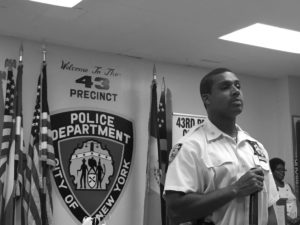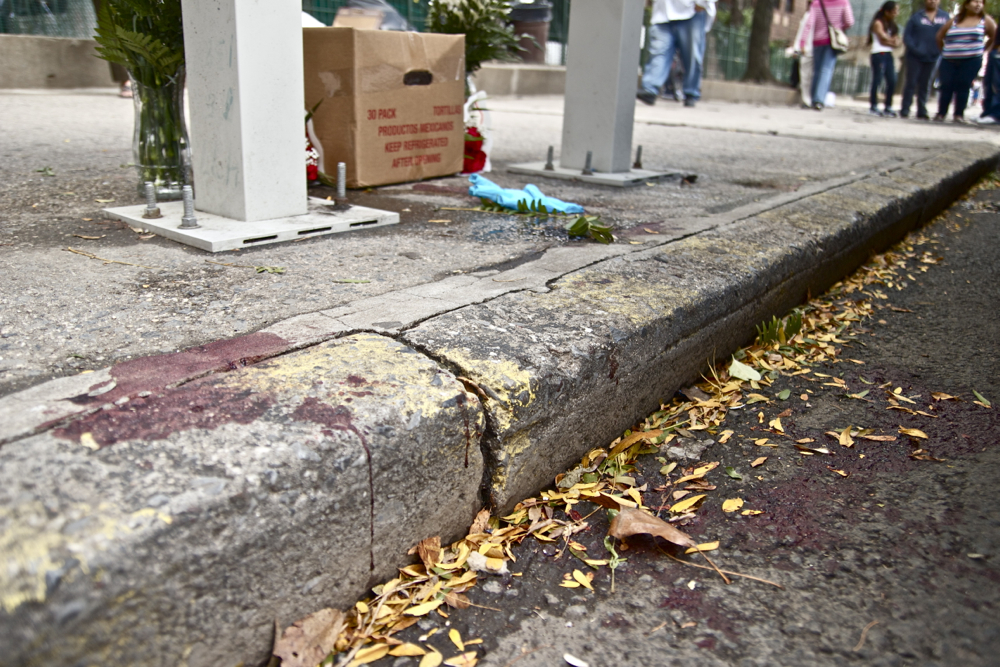On Sept. 5th, in the early hours of the morning, Natasha Roberts, 46, was in her Parkchester apartment building, when she was fatally stabbed by her husband Jimmy Roberts, police allege.
Responding to a 911 call, police arrived at Natasha Robert’s apartment and found her with stab wounds to her torso. Jimmy Roberts also had stab wounds. Two knives were found at the scene.
“My wife stabbed me and then I stabbed her,” Jimmy Roberts repeatedly said, during his arrest.
The couple had a history of domestic violence. An order of protection issued in June this year forbade Jimmy Roberts from approaching Natasha Roberts or her home.
Hours after that 911 call, shocked gasps reverberated around the room as Deputy Detective Benjamin Gurley informed those at the South East Bronx Community Council meeting of the husband and wife stabbing. “We are struggling with homicide,” said Gurley, “the main issue is domestic violence.”

Dep. Det. Gurley addresses community members at the South East Bronx Council meeting
Photo credit: Joasia E. Popowicz
Five days later, at the Bronx Criminal Supreme court, the door to the right of the hushed court opened and a man accused of murdering his wife stepped out. “C*cksucker,” came the insults from the court pews.
Virgis Solis, 58, walked handcuffed through the courtroom and looked straight at his hecklers sitting at the back of the courtroom.
Solis is accused of repeatedly stabbing his wife, Valarie Solis, in the neck and torso.
The incidents are just two of an increasing number of domestic homicides in the Bronx and the city, against a stark rise in domestic violence reports.
Last year, there were no domestic homicides in the South East Bronx, where Roberts lived. This year, there have been five between January and September 2018. And in the entire borough, there have been 14 domestic homicides, up from eight in the same period last year. City-wide, the total has gone up from 36, to 38.
The rise in domestic homicides comes after police reported the lowest crime rates in the city since 1951. Police statistics show that in 2017, about 96,000 crimes were reported compared to 102,000 in 2016. Mayor Bill De Blasio called 2017 the “the safest year in modern New York City history.”
New York’s streets may be getting safer but domestic violence has been rising since 2015.
According to the Mayor’s Office to Combat Domestic Violence, city-wide, domestic violence reports rose for three years in a row to 109,000 in 2017 from 75,000 in 2015, up 45%. In the Bronx, it’s a similar story, with 28,000 domestic violence reports in 2017 up from 17,000 in 2015, a rise of 61%.

Domestic violence reports have increased city-wide and in the Bronx since 2015
Graph: Joasia E. Popowicz. Mayor’s Office to Combat Domestic Violence
Domestic violence is a complex issue and there is no one single explanation as to why it’s increasing, according to experts. But unaffordable housing and unemployment are important factors in the rise, according to Tanneh L. Wreh, a Bronx social worker associated with the Career Program at Hostos Community College.
“Women are now depending on a partner to halve that share of their rent or cover their housing,” Wreh said, who works closely with women experiencing domestic violence. Women are staying in abusive relationships because they can’t afford to leave.
Housing “is a factor when you’re not working or if you’re working and making minimum wage,” she said.
More than a third of domestic homicides in New York were in the Bronx this year, a borough especially impacted by rising rents and high unemployment.
The Bronx has the highest unemployment rates in both the city and the state: 6.1 percent as of July 2018, according to the latest figures by the U.S. Bureau of Labor Statistics. And, over half of all households are rent burdened, defined as paying anywhere between 30 percent or more of their income on rent, according to a 2017 report published in by the Regional Plan Organization, a leading urban planning research institute.
Unemployment and rent burdens are also reasons why perpetrators resort to violence in the first place, according to Wreh.
“Control. It’s a control thing,” she said. Perpetrators, not being able to control other aspects of their lives, “would like to have that control or power over another individual.”
Studies published by the U.S. National Institute of Justice, the Department of Justice’s governmental research agency, link financial pressure to domestic violence and homicide. The lower the household income, the higher the domestic violence rates and reducing benefits increased domestic homicides.
As was the case with Natasha Roberts’ death, a history of domestic violence is a red flag for risk of homicide, according to the Center for Disease Control and Prevention. “Approximately one in 10 victims of intimate partner violence homicide were reported to have experienced violence in the month preceding their deaths,” according to the CDC.
Police in the South East Bronx make preventive home visits to houses with a history of domestic violence, Gurley said. But, these efforts have not been enough to stop the rise in domestic violence and domestic homicides.
Domestic violence also goes underreported, according to Wreh, which could be one of the reasons for the increase in homicides.
Women are reluctant to make themselves and their situation known to police in the first place because of the potential upheaval, Wreh said. Reporting domestic violence doesn’t just affect the perpetrator.
Women think, “I’m going to be reporting this and I’m going to have to be removed from the housing, going to a shelter until I can find a new place to live – it’s a setback, ” she said.
There are alternatives to police that women can turn to for help, Gurley said. Police work with Safe Horizon, the nation’s leading anti-violence organization. They have an office in the Bronx and can help with housing, counseling and legal services.
But, even if women know services exist, they may be reluctant to seek help because of perceived social stigma and fear of what others will think of them, according to Wreh. However, there are many women going through the same thing, she said.
Jimmy Robert’s next court hearing is Jan. 2nd, 2019. Virgil Solis’s is one week later, on Jan. 9th, 2019. Both are at the Bronx Supreme Criminal Court.












